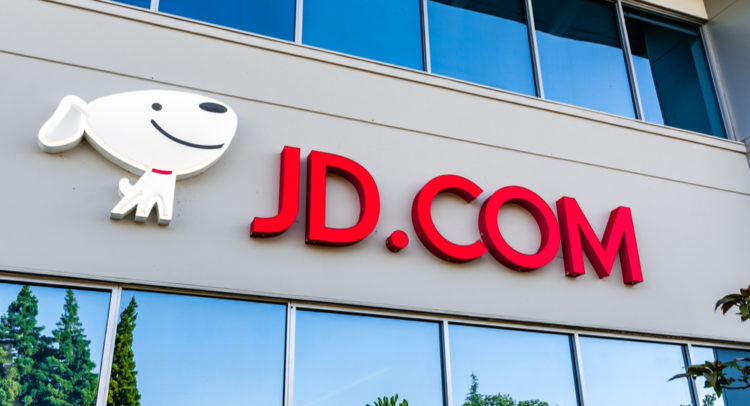Founded in 1998, JD.com (JD) has come a long way from being a small electronics shop named 360buy. Currently, JD is one of the largest e-commerce companies in China in terms of transaction volume and revenue. It has also managed to secure a position among the Fortune Global 500 companies of the world.
Often termed the “Amazon of China,” JD.com follows a business model that is surprisingly similar to that of Amazon (AMZN). JD.com drives its e-commerce prowess by focusing on customer satisfaction via its strong and growing domestic logistics network and high-powered industry partnerships. This Chinese e-commerce giant is backed by top global companies, including Tencent (TCEHY), Walmart (WMT), and Google (GOOG).
Similar to Amazon, JD functions as both a first-party e-commerce player and a third-party marketplace. Moreover, it has developed a highly expansive delivery logistical network for both third-party and JD shippers.
I remain bullish on this stock and believe JD could be one of the best e-commerce plays globally in the decade to come. Here’s why I think JD’s “Amazon-like” business model is one long-term investors may want to pay notice to.
A Loyalty Program Like Prime
Amazon Prime has been one of the most significant revenue drivers for the American e-commerce company. This service provides free-one day shipping along with video streaming services. Prime comes with about 150 million customers throughout the globe and serves as an economic buffer for the company.
Similar to Prime, JD launched its own loyalty program called JD Plus 6 years ago, which has garnered more than 20 million users up to now. JD Plus partners with 600+ industry-leading brands to offer deals, discounts, and other benefits in movies, hotel booking, dining, fitness, and more.
By providing a program with bundled services, JD has been able to increase its average revenue per user multiple times over. This is quite similar to Amazon, where an average Amazon Prime member spends $1,400 yearly on Amazon compared to a non-Prime member spending $600 annually.
Development of Private-Label Brand Selling Household Products
JD.com launched its own manufacturing brand, offering a wide range of products from beddings to bath towels. This move put the online retailer in direct competition with the brands that sell their products through its platform.
Private-label branding is a strategy utilized by Amazon and many other large-scale retailers. By controlling the entire process, from manufacturing to sale, Amazon and JD are both able to maximize their value capture along the value chain. Additionally, product quality and shipping concerns are alleviated with this strategy.
Like Amazon, JD uses purchase data obtained by customers to optimize which products are chosen for private label and which ones aren’t. This has allowed JD to prioritize its offering and make it ultra-popular among the Chinese consumer base.
JD’s strategy to develop a house brand is very similar to that of AmazonBasics, which Jeff Bezos introduced back in 2009 to manufacture electric items. Today it produces and sells numerous products ranging from travel gear, daily items, appliances, and more.
Expanding to New Categories
Amazon began its humble journey as a bookseller, which was followed by a foray into media, electronics, household essentials, and more. JD’s core business lies in electronics and home appliances. This category still makes up for more than half of JD’s revenue. However, other categories have been expanding at a rapid pace.
The company has been leveraging its prowess in the electronic segment to boost other product segments.
JD’s net revenue and operating margin have also been jumping up with every quarter like that of Amazon. Its net product revenue jumped 23.3% on a year-over-year basis reaching $34 billion. The net service revenue also climbed 49.2% year-over-year and stood at $5.3 billion. On the other hand, retail revenue grew 22.7% to $36 billion.
Wall Street’s Take
Turning to Wall Street, JD stock earns a Strong Buy consensus rating. Out of 15 analyst ratings, there are 14 Buys and one Hold recommendation.
The average JD.com price target is $106.73, implying 55% upside potential. Analyst price targets range from a high of $123 per share to a low of $95 per share.

Bottom Line
Strategically, there’s a lot to like about how JD has positioned its overall business. Comparing JD to Amazon really shines a light on why many investors choose this Chinese e-commerce stock over others. Indeed, looking across Chinese e-commerce giants, JD’s business model does seem closest to that of U.S. rival Amazon.
JD has been expanding its operations aggressively of late, resulting in significant capital expenditures in the near term. However, as China lowers interest rates, JD should be able to borrow money cheaper to boost its growth. Any sort of economic boom in China would be bullish for JD, a company that recently broke its own records for Singles Day sales last November.
The regulatory environment in China remains difficult to navigate. However, among the best Chinese stocks to watch right now, JD needs to be high up on the list for growth investors.
Download the TipRanks mobile app now
To find good ideas for stocks trading at attractive valuations, visit TipRanks’ Best Stocks to Buy, a newly launched tool that unites all of TipRanks’ equity insights.
Read full Disclaimer & Disclosure









